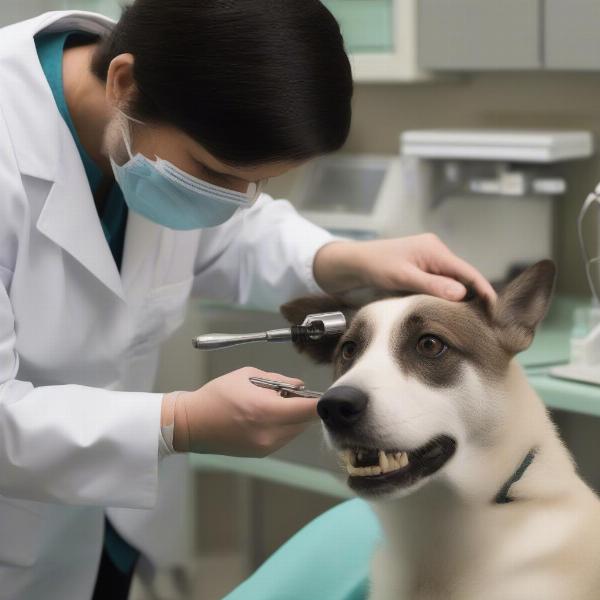Understanding the cost of canine tooth extraction in dogs is crucial for responsible pet ownership. This procedure can be necessary for various reasons, impacting your dog’s health and your budget. This guide will explore the factors influencing dog canine tooth extraction cost, offering insights into average prices, potential additional expenses, and ways to manage the financial aspect of this important veterinary procedure.
Factors Affecting Dog Canine Tooth Extraction Cost
Several factors contribute to the overall cost of extracting a canine tooth in a dog. These include:
- Geographic Location: Veterinary costs, like most services, vary by location. Generally, metropolitan areas tend to have higher prices than rural areas.
- Veterinary Clinic: Different clinics have different fee structures. Specialty veterinary hospitals or emergency clinics often charge more than general practices.
- Complexity of the Extraction: A simple extraction of a loose tooth will cost less than a complex extraction involving fractured roots or impacted teeth.
- Dog’s Size and Breed: Larger dogs typically require more anesthetic, which can increase the overall cost. Some breeds are also predisposed to dental issues, potentially leading to more complicated extractions.
- Additional Procedures: Pre-operative blood work, pain medication, antibiotics, and follow-up care contribute to the total cost. X-rays are often necessary to assess the tooth’s condition.
Understanding the Average Cost
While the cost can vary significantly, a simple canine tooth extraction typically ranges from $100 to $300. More complex extractions involving surgery or multiple teeth can range from $500 to $1,000 or more. It’s essential to get a clear estimate from your veterinarian before proceeding.
What Does the Cost Typically Include?
The quoted price for a canine tooth extraction usually covers the extraction procedure itself, anesthesia, and pain medication during the procedure. It might also include pre-operative examination and post-operative pain medication for a few days. However, always confirm what is included in the quote to avoid surprises.
Hidden Costs to Consider
Be prepared for potential additional expenses, such as:
- Pre-anesthetic blood work: This is vital for assessing your dog’s overall health and ensuring they can safely undergo anesthesia.
- X-rays: Necessary to evaluate the tooth and surrounding bone structure.
- Medications: Pain relievers and antibiotics are often prescribed post-extraction.
- Follow-up visits: Your veterinarian may need to monitor the healing process.
Managing the Cost of Dog Canine Tooth Extraction
Financial constraints shouldn’t prevent your dog from receiving necessary dental care. Here are some ways to manage the cost:
- Pet Insurance: Consider purchasing pet insurance before dental issues arise. Many policies cover a portion of dental procedures.
- Payment Plans: Some veterinary clinics offer payment plans to spread the cost over time.
- Dental Savings Plans: Some clinics offer annual dental plans that cover routine cleanings and may offer discounts on extractions.
 Dog Receiving Professional Dental Care at a Veterinary Clinic
Dog Receiving Professional Dental Care at a Veterinary Clinic - Financial Assistance: Several organizations offer financial aid for veterinary care. Research local and national resources.
- Low-Cost Clinics: Explore options for low-cost veterinary clinics or dental specialists in your area. Check dog dentist prices uk for more information.
Conclusion
Canine tooth extraction in dogs is a common procedure with varying costs depending on several factors. Understanding these factors and exploring financial options allows you to provide the best possible care for your furry friend without undue financial burden. Remember to consult your veterinarian for a precise estimate and discuss any concerns you may have about the cost of the procedure. Getting informed about dog tooth extraction cost is a crucial step in responsible pet ownership.
FAQ
- How long does a canine tooth extraction take? Typically, the procedure itself takes about 30-60 minutes, but the overall appointment may be longer due to anesthesia and recovery time.
- Is canine tooth extraction painful for dogs? Dogs are under general anesthesia during the procedure, so they don’t feel any pain. Pain medication is provided post-operatively.
- What are the signs my dog needs a canine tooth extraction? Bad breath, bleeding gums, difficulty eating, and swelling around the mouth are potential signs.
- Can a dog live without its canine teeth? Yes, dogs can adapt to life without their canine teeth, but it’s important to monitor their eating habits and provide appropriate care.
- How can I prevent the need for canine tooth extraction in my dog? Regular brushing, dental chews, and professional dental cleanings can help maintain good oral hygiene and prevent future dental problems. Check out information about dog tooth decay stages pictures for early detection.
- What is the recovery time for canine tooth extraction? Most dogs recover within a week or two, but it’s important to follow your veterinarian’s instructions for post-operative care. You might also find useful information about tooth removal dog cost.
- Are there any alternatives to canine tooth extraction? In some cases, root canal therapy might be an option, but this depends on the severity of the tooth damage. Discuss alternatives with your vet. Consider finding a low cost dog dentist.
ILM Dog is a leading international pet care website dedicated to providing expert advice on all aspects of dog care and well-being. We cover a wide range of topics, from breed selection and health to training, nutrition, grooming, and product recommendations. Our expertise in canine health and wellness can help you provide the best possible care for your beloved companion. Contact us for expert advice. Email: [email protected] Phone: +44 20-3965-8624. Visit ILM Dog for more information.